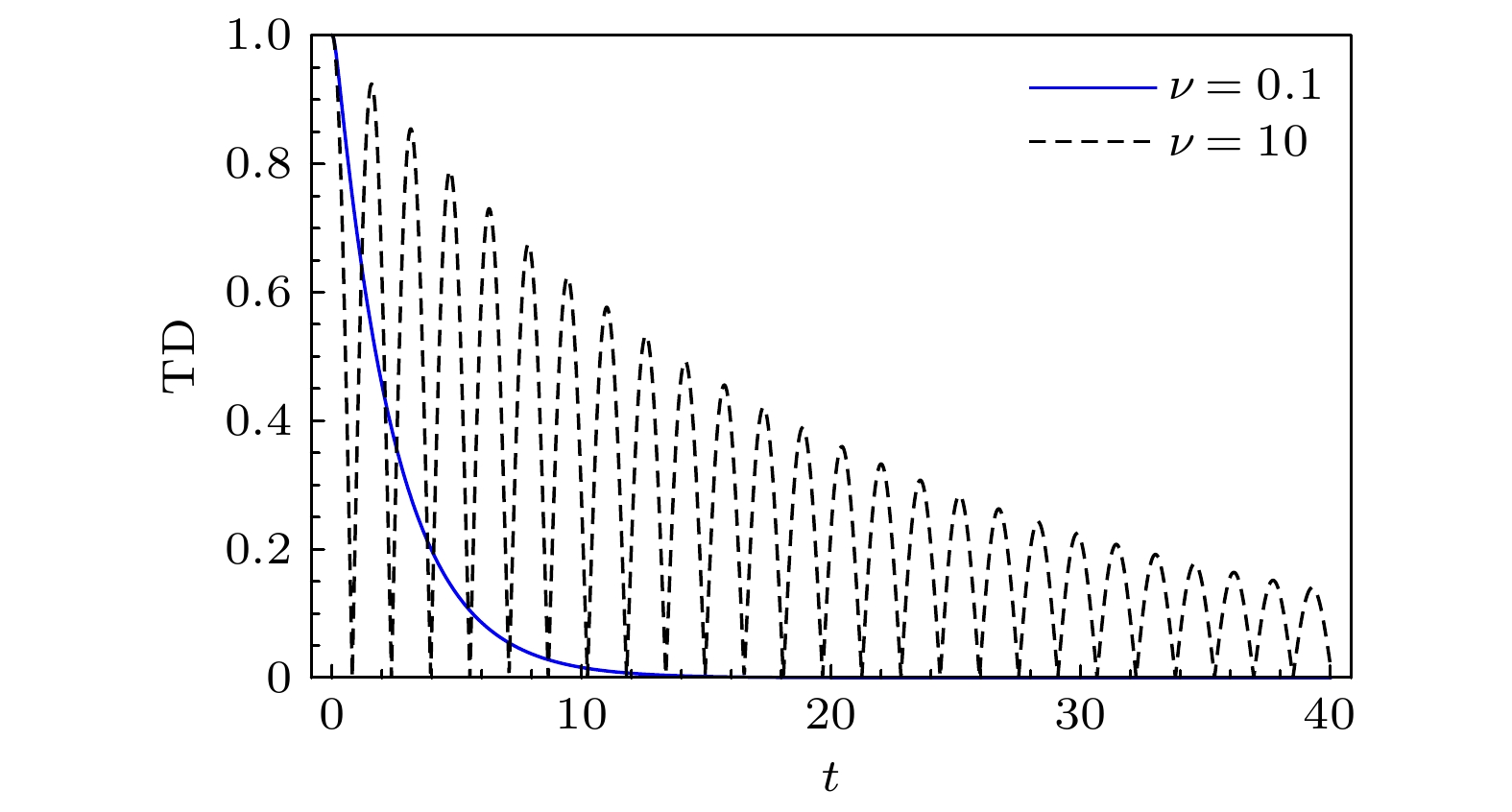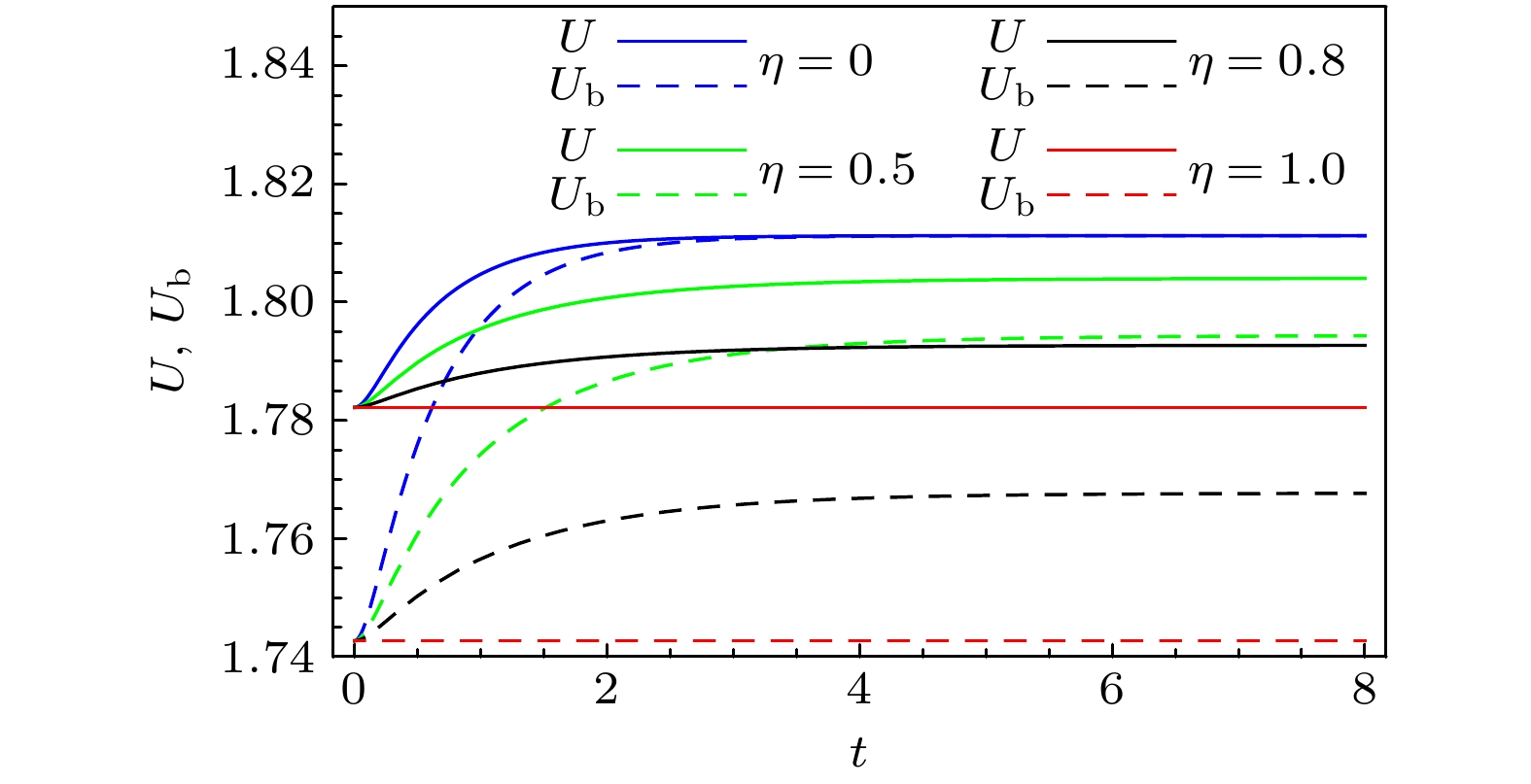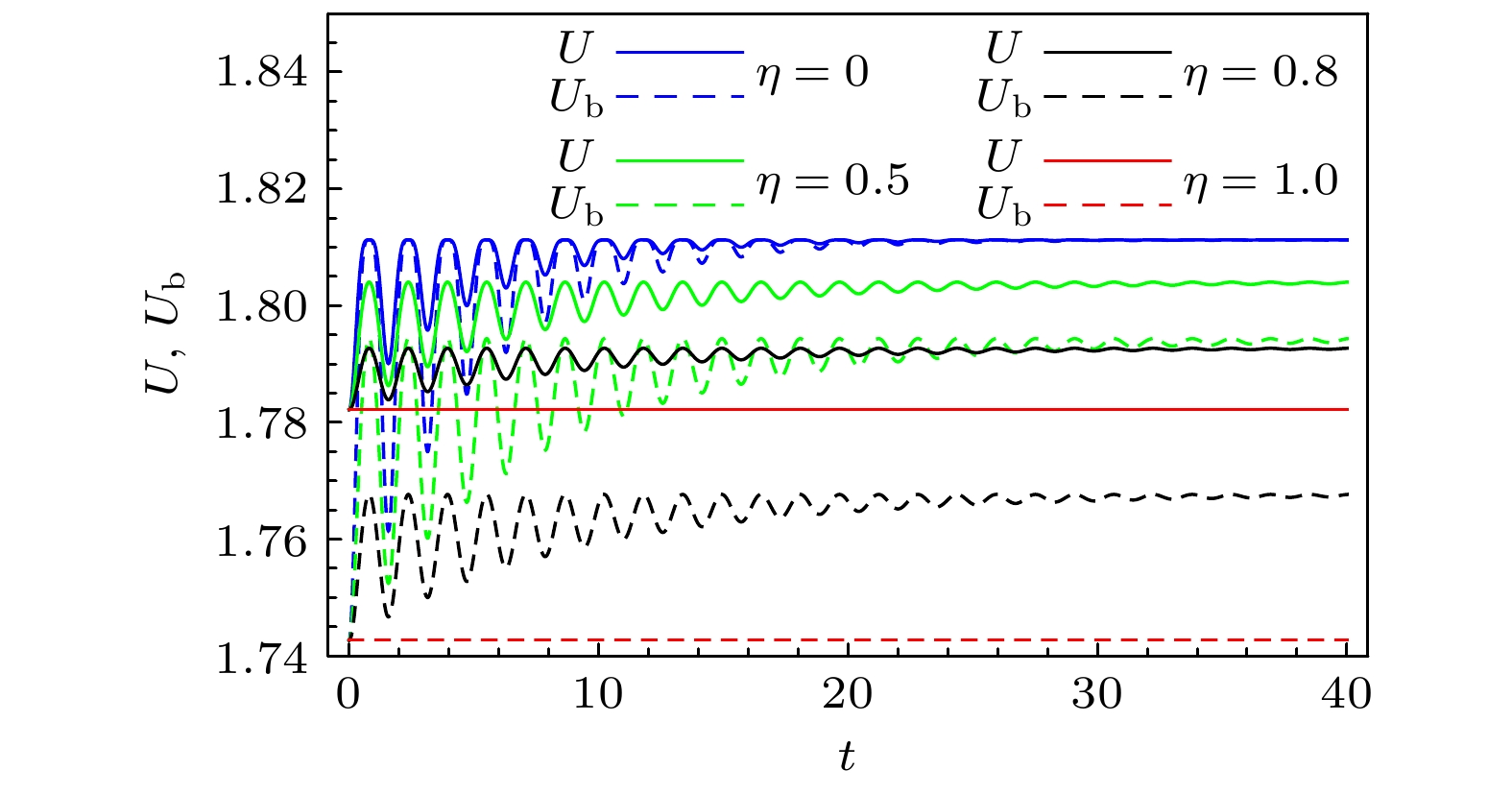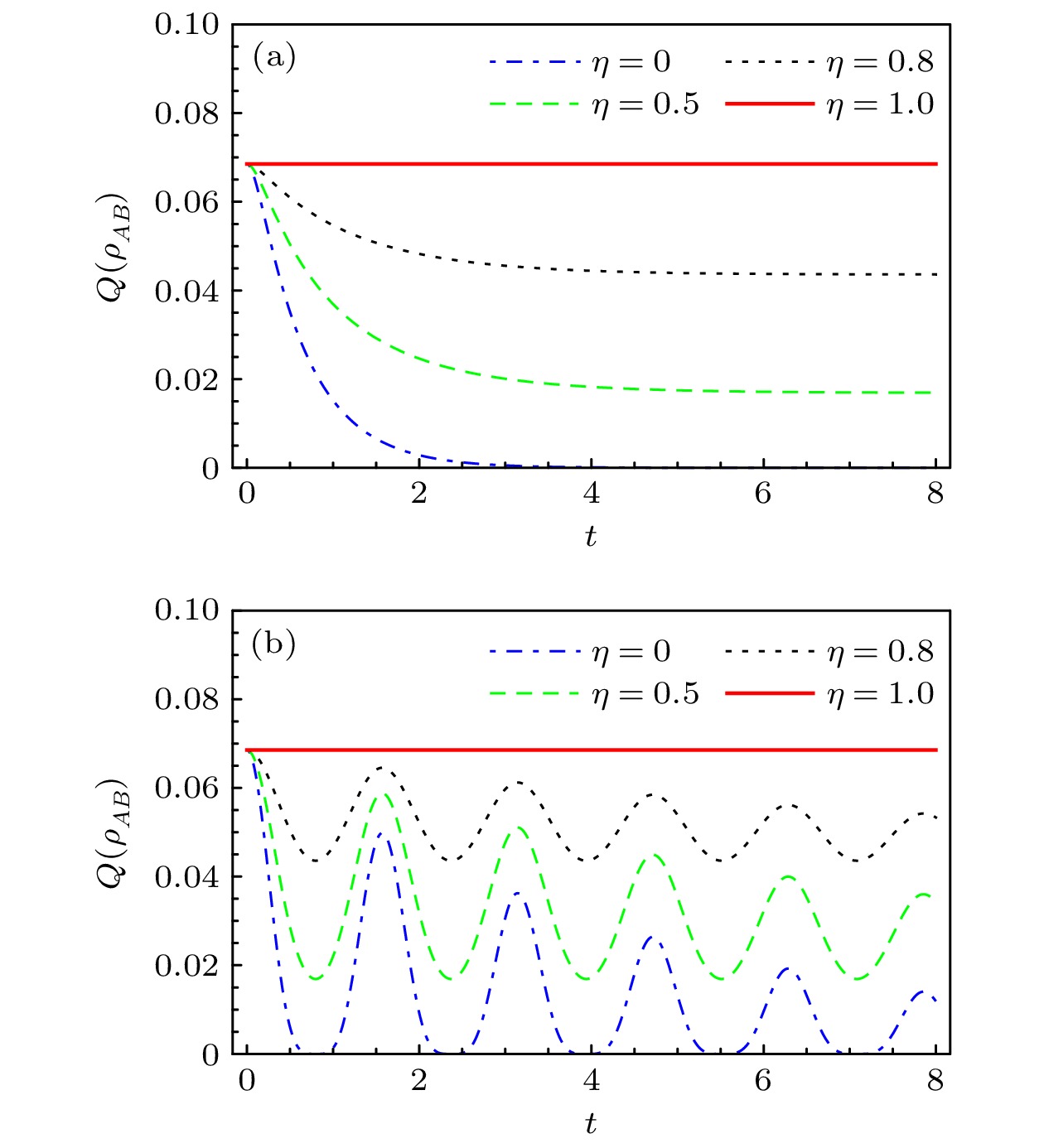-
不确定性原理限制了观察者对两个不相容可观测量的精确测量能力, 在量子信息科学领域的量子精密测量中扮演着重要角色. 本文研究关联退相位有色噪声通道下两量子比特系统的量子存储支撑熵不确定关系, 结合通道连续使用间的关联性和动力学演化中的非马尔科夫性调控熵不确定度及其下限. 分别选取最大纠缠态和可分离态作为系统的初态, 通过调节关联强度和非马尔科夫性发现: 完全关联通道可以最大程度地抑制退相干, 降低熵不确定度及其下限, 此时非马尔科夫效应不发挥作用; 部分关联通道与非马尔科夫效应结合可以在演化中某些时刻更有效地降低熵不确定度及其下限; 长时间演化后, 系统的熵不确定度及下限达到稳定值, 且稳定值只与通道的关联强度有关, 通道的关联性越强, 稳态的熵不确定度及下限越低. 最后分析熵不确定性及其下限降低的物理本质, 发现熵不确定度及其下限的降低源于系统量子关联的增加.The uncertainty principle limits the ability for observer to precisely measure two incompatible observables, and plays a crucial role in quantum precision measurement in the quantum information science. When quantum systems interact with their surroundings, they inevitably result in decoherence, which increases the uncertainty of the system. In the process of quantum information processing, the effective regulation of uncertainty becomes a key problem that needs to be solved. In this work, we investigate the quantum-memory-assisted entropic uncertainty relation of a two-qubit system under correlated channels with dephasing colored noise. We demonstrate that it is possible to control the entropic uncertainty, U, and its lower bound, Ub, by combining correlations between successive uses of channels and the non-Markovianity of the dynamical evolution. Firstly, the evolutionary characteristics of the trace distance are employed to distinguish between Markovianity and non-Markovianity of the channel. Subsequently, the system is selected to be either a maximally entangled state or separated state initially. By adjusting the strength η of the correlations, we find that with the increase of η, the entropic uncertainty and its lower bound decrease. Especially, if the channel is fully correlated (η = 1), the entropic uncertainty and its lower bound remain constant under the channel, indicating that decoherence is completely suppressed. A comparison of Markovian channel with non-Markovian channel reveals that the entropic uncertainty and its lower bound exhibit oscillatory behaviour under non-Markovian channels. The combination of correlations and non-Markovianity of the channel demonstrates that the entropic uncertainty and its lower bound can be reduced under fully correlated channels where the non-Markovianity has no effect. This is because fully correlated channels suppress decoherence to a greatest extent. Under partially correlated channels, the combination of correlations and non-Markovianity can more effectively reduce the entropic uncertainty and its lower bound. Under such channels, correlations of the channel reduce the entropic uncertainty and its lower bound during the whole evolution, while the non-Markovianity contributes to their oscillations and reduce them in some specific time. Furthermore, the results show that the entropic uncertainty and its lower bound reach steady values that depend only on the strength of the correlations after long-time evolution. In other words, the stronger the correlations, the lower the entropy uncertainty and its lower bound of steady states will be. Finally, we analyse the physical nature of the decrease of the entropic uncertainty and its lower bound, and it is found that the decrease of the entropic uncertainty and its lower bound originate from the increase of the quantum correlations in the system.
-
Keywords:
- uncertainty relation /
- correlated channel /
- non-Markovianity /
- quantum correlation
[1] Heisenberg W 1927 Z. Phys. 43 172
 Google Scholar
Google Scholar
[2] Robertson H P 1929 Phys. Rev. 34 163
 Google Scholar
Google Scholar
[3] Deutsch D 1983 Phys. Rev. Lett. 50 631
 Google Scholar
Google Scholar
[4] Kraus K 1987 Phys. Rev. D 35 3070
 Google Scholar
Google Scholar
[5] Maassen H, Uffink J B M 1988 Phys. Rev. Lett. 60 1103
 Google Scholar
Google Scholar
[6] Berta M, Christandl M, Colbeck R, Renes J M, Renner R 2010 Nat. Phys. 6 659
 Google Scholar
Google Scholar
[7] Prevedel R, Hamel D R, Colbeck R, Fisher K, Resch K J 2011 Nat. Phys. 7 757
 Google Scholar
Google Scholar
[8] Li C F, Xu J S, Xu X Y, Li K, Guo G C 2011 Nat. Phys. 7 752
 Google Scholar
Google Scholar
[9] Shi J, Ding Z, Wu T, He J, Yu L, Sun W, Wang D, Ye L 2017 Laser Phys. Lett. 14 125208
 Google Scholar
Google Scholar
[10] Hall M J W, Cerf N J 2012 New J. Phys. 14 033040
 Google Scholar
Google Scholar
[11] Ekert A K 1991 Phys. Rev. Lett 67 661
 Google Scholar
Google Scholar
[12] Renes J M, Boileau J C 2009 Phys. Rev. Lett 103 020402
 Google Scholar
Google Scholar
[13] Haseli S, Dolatkhah H, Rangani Jahromi H, Salimi S, Khorashad A S 2020 Opt. Commun. 461 125287
 Google Scholar
Google Scholar
[14] Tomamichel M, Lim C C W, Gisin N, Renner R 2012 Nat. Commun. 3 634
 Google Scholar
Google Scholar
[15] Ng N H Y, Berta M, Wehner S 2012 Phys. Rev. A 86 042315
 Google Scholar
Google Scholar
[16] Ming F, Wang D, Shi W N, Huang A J, Du M M, Sun W Y, Ye L 2018 Quantum Inf. Process. 17 267
 Google Scholar
Google Scholar
[17] Li L J, Ming F, Shi W N, Ye L, Wang D 2021 Physica E 133 114802
 Google Scholar
Google Scholar
[18] Wang D, Ming F, Huang A J, Sun W Y, Shi J D, Ye L 2017 Laser Phys. Lett. 14 055205
 Google Scholar
Google Scholar
[19] Wang D, Ming F, Song X K, Ye L, Chen J L 2020 Eur. Phys. J. C 80 800
 Google Scholar
Google Scholar
[20] Li L J, Ming F, Song X K, Ye L, Wang D 2021 Eur. Phys. J. C 81 72
 Google Scholar
Google Scholar
[21] Wang T Y, Wang D 2024 Phys. Lett. B 855 138876
 Google Scholar
Google Scholar
[22] Wang T Y, Wang D 2024 Phys. Lett. A 499 129364
 Google Scholar
Google Scholar
[23] Wu L, Ye L, Wang D 2022 Phys. Rev. A 106 062219
 Google Scholar
Google Scholar
[24] Xie B F, Ming F, Wang D, Ye L, Chen J L 2021 Phys. Rev. A 104 062204
 Google Scholar
Google Scholar
[25] Ming F, Wang D, Fan X G, Shi W N, Ye L, Chen J L 2020 Phys. Rev. A 102 012206
 Google Scholar
Google Scholar
[26] Bouafia Z, Oumennana M, Mansour M, Ouchni F 2024 Appl. Phys. B 130 94
 Google Scholar
Google Scholar
[27] Abdel-Wahab N H, Ibrahim T A S, Amin M E, Salah A 2024 Eur. Phys. J. D 78 28
 Google Scholar
Google Scholar
[28] Macchiavello C, Palma G M 2002 Phys. Rev. A 65 050301
 Google Scholar
Google Scholar
[29] D’Arrigo A, Benenti G, Falci G 2007 New. J. Phys. 9 310
 Google Scholar
Google Scholar
[30] D’Arrigo A, Benenti G, Falci G 2013 Phys. Rev. A 88 042337
 Google Scholar
Google Scholar
[31] Sk R, Panigrehi P K 2024 Phys. Rev. A 109 032425
 Google Scholar
Google Scholar
[32] Guo Y N, Fang M F, Wang G Y, Zeng K 2016 Quantum Inf. Process. 15 5129
 Google Scholar
Google Scholar
[33] Peng Z Y, Wu F L, Li J, Xue H N, Liu S Y, Wang Z Y 2023 Phys. Rev. A 107 022405
 Google Scholar
Google Scholar
[34] Yu M, Guo Y N 2024 Int. J. Theor. Phys. 63 156
 Google Scholar
Google Scholar
[35] Xie Y X, Qin Z Y 2020 Quantum Inf. Process. 19 375
 Google Scholar
Google Scholar
[36] 董曜, 纪爱玲, 张国锋 2022 71 070303
 Google Scholar
Google Scholar
Dong Y, Ji A L, Zhang G F 2022 Acta Phys. Sin. 71 070303
 Google Scholar
Google Scholar
[37] Zhang D H, Wu F L, Peng Z Y, Wang L, Liu S Y 2023 Quantum Inf. Process. 22 120
 Google Scholar
Google Scholar
[38] Xu K, Zhang G F, Liu W M 2019 Phys. Rev. A 100 052305
 Google Scholar
Google Scholar
[39] Haseli S, Hadipour M 2022 Int. J. Theor. Phys. 61 117
 Google Scholar
Google Scholar
[40] Awasthi N, Joshi D K, Sachdev S 2022 Int. J. Theor. Phys. 61 123
 Google Scholar
Google Scholar
[41] Hou L, Zhang Y , Zhu Y 2023 Int. J. Theor. Phys. 62 221
 Google Scholar
Google Scholar
[42] Lindblad G 1976 Comm. Math. Phys. 48 119
 Google Scholar
Google Scholar
[43] Wolf M M, Eisert J, Cubitt T S, Cirac J I 2008 Phys. Rev. Lett. 101 150402
 Google Scholar
Google Scholar
[44] Lambert N, Chen Y N, Cheng Y C, Li C M, Chen G Y, Nori F 2013 Nat. Phys. 9 10
 Google Scholar
Google Scholar
[45] Hwang B, Goan H S 2012 Phys. Rev. A 85 032321
 Google Scholar
Google Scholar
[46] Banu H, Rao K R 2024 Eur. Phys. J. Plus 139 436
 Google Scholar
Google Scholar
[47] Addis C, Karpat G, Macchiavello C, Maniscalco 2016 Phys. Rev. A 94 032121
 Google Scholar
Google Scholar
[48] Awasthi N, Haseli S, Johri U C, Salimi S, Dolatkhah H 2020 Quantum Inf. Process. 19 10
 Google Scholar
Google Scholar
[49] Wang G Y, Guo Y N, Zeng K 2019 J. Mod. Opt. 66 367
 Google Scholar
Google Scholar
[50] 李丽娟, 明飞, 宋学科, 叶柳, 王栋 2022 71 070302
 Google Scholar
Google Scholar
Li L J, Ming F, Song X K, Ye L, Wang D 2022 Acta Phys. Sin. 71 070302
 Google Scholar
Google Scholar
[51] Hajihoseinlou H, Ahansaz B 2024 Laser Phys. 34 075202
 Google Scholar
Google Scholar
[52] Daffer S, Wodkiewicz K, Cresser J D, McIver J K 2004 Phys. Rev. A 70 010304(R
 Google Scholar
Google Scholar
[53] Cai X 2020 Sci. Rep. 10 88
 Google Scholar
Google Scholar
[54] Breuer H P, Laine E M, Piilo J 2009 Phys. Rev. Lett. 103 210401
 Google Scholar
Google Scholar
[55] Chen M N, Wang D, Ye L 2019 Phys. Lett. A 383 977
 Google Scholar
Google Scholar
[56] Wang D, Huang A J, Hoehn R D, Ming F, Sun W Y, Shi J Dong, Ye L, Kais S 2017 Sci. Rep. 7 1066
 Google Scholar
Google Scholar
[57] Xu Z Y, Yang W L, Feng M 2012 Phys. Rev. A 86 012113
 Google Scholar
Google Scholar
[58] Hu M L, Zhou W 2019 Laser Phys. Lett. 16 045201
 Google Scholar
Google Scholar
[59] Hu M L, Fan H 2020 Sci. China-Phys. Mech. Astron. 63 230322
 Google Scholar
Google Scholar
[60] Hu M L, Zhang Y H, Fan H 2021 Chin. Phys. B 30 030308
 Google Scholar
Google Scholar
[61] Wootters W K 1998 Phys. Rev. Lett. 80 2245
 Google Scholar
Google Scholar
[62] Ollivier H, Zurek W H 2001 Phys. Rev. Lett. 88 017901
 Google Scholar
Google Scholar
[63] Mazzola L, Piilo J, Maniscalco S 2011 Int. J. Quantum Inf. 09 981
 Google Scholar
Google Scholar
[64] Pati A K, Wilde M M, Devi A R U, Rajagopal A K, Sudha 2012 Phys. Rev. A 86 042105
 Google Scholar
Google Scholar
[65] Hu M L, Fan H 2013 Phys. Rev. A 88 014105
 Google Scholar
Google Scholar
[66] Hu M L, Fan H 2013 Phys. Rev. A 87 022314
 Google Scholar
Google Scholar
-
图 6 初态为可分离态时量子关联$ Q({\boldsymbol{\rho}}_{AB}) $随时间的演化(a)通道参数$ \nu= 0.1 $, 呈现马尔科夫性; (b)通道参数$ \nu=10 $, 呈现非马尔科夫性
Fig. 6. Evolution of quantum correlations $ Q({\boldsymbol{\rho}}_{AB}) $ of the system which is initially in a separated state: (a) The channel is Markovian, where $ \nu=0.1 $; (b) the channel is non-Markovian, where $ \nu=10 $.
-
[1] Heisenberg W 1927 Z. Phys. 43 172
 Google Scholar
Google Scholar
[2] Robertson H P 1929 Phys. Rev. 34 163
 Google Scholar
Google Scholar
[3] Deutsch D 1983 Phys. Rev. Lett. 50 631
 Google Scholar
Google Scholar
[4] Kraus K 1987 Phys. Rev. D 35 3070
 Google Scholar
Google Scholar
[5] Maassen H, Uffink J B M 1988 Phys. Rev. Lett. 60 1103
 Google Scholar
Google Scholar
[6] Berta M, Christandl M, Colbeck R, Renes J M, Renner R 2010 Nat. Phys. 6 659
 Google Scholar
Google Scholar
[7] Prevedel R, Hamel D R, Colbeck R, Fisher K, Resch K J 2011 Nat. Phys. 7 757
 Google Scholar
Google Scholar
[8] Li C F, Xu J S, Xu X Y, Li K, Guo G C 2011 Nat. Phys. 7 752
 Google Scholar
Google Scholar
[9] Shi J, Ding Z, Wu T, He J, Yu L, Sun W, Wang D, Ye L 2017 Laser Phys. Lett. 14 125208
 Google Scholar
Google Scholar
[10] Hall M J W, Cerf N J 2012 New J. Phys. 14 033040
 Google Scholar
Google Scholar
[11] Ekert A K 1991 Phys. Rev. Lett 67 661
 Google Scholar
Google Scholar
[12] Renes J M, Boileau J C 2009 Phys. Rev. Lett 103 020402
 Google Scholar
Google Scholar
[13] Haseli S, Dolatkhah H, Rangani Jahromi H, Salimi S, Khorashad A S 2020 Opt. Commun. 461 125287
 Google Scholar
Google Scholar
[14] Tomamichel M, Lim C C W, Gisin N, Renner R 2012 Nat. Commun. 3 634
 Google Scholar
Google Scholar
[15] Ng N H Y, Berta M, Wehner S 2012 Phys. Rev. A 86 042315
 Google Scholar
Google Scholar
[16] Ming F, Wang D, Shi W N, Huang A J, Du M M, Sun W Y, Ye L 2018 Quantum Inf. Process. 17 267
 Google Scholar
Google Scholar
[17] Li L J, Ming F, Shi W N, Ye L, Wang D 2021 Physica E 133 114802
 Google Scholar
Google Scholar
[18] Wang D, Ming F, Huang A J, Sun W Y, Shi J D, Ye L 2017 Laser Phys. Lett. 14 055205
 Google Scholar
Google Scholar
[19] Wang D, Ming F, Song X K, Ye L, Chen J L 2020 Eur. Phys. J. C 80 800
 Google Scholar
Google Scholar
[20] Li L J, Ming F, Song X K, Ye L, Wang D 2021 Eur. Phys. J. C 81 72
 Google Scholar
Google Scholar
[21] Wang T Y, Wang D 2024 Phys. Lett. B 855 138876
 Google Scholar
Google Scholar
[22] Wang T Y, Wang D 2024 Phys. Lett. A 499 129364
 Google Scholar
Google Scholar
[23] Wu L, Ye L, Wang D 2022 Phys. Rev. A 106 062219
 Google Scholar
Google Scholar
[24] Xie B F, Ming F, Wang D, Ye L, Chen J L 2021 Phys. Rev. A 104 062204
 Google Scholar
Google Scholar
[25] Ming F, Wang D, Fan X G, Shi W N, Ye L, Chen J L 2020 Phys. Rev. A 102 012206
 Google Scholar
Google Scholar
[26] Bouafia Z, Oumennana M, Mansour M, Ouchni F 2024 Appl. Phys. B 130 94
 Google Scholar
Google Scholar
[27] Abdel-Wahab N H, Ibrahim T A S, Amin M E, Salah A 2024 Eur. Phys. J. D 78 28
 Google Scholar
Google Scholar
[28] Macchiavello C, Palma G M 2002 Phys. Rev. A 65 050301
 Google Scholar
Google Scholar
[29] D’Arrigo A, Benenti G, Falci G 2007 New. J. Phys. 9 310
 Google Scholar
Google Scholar
[30] D’Arrigo A, Benenti G, Falci G 2013 Phys. Rev. A 88 042337
 Google Scholar
Google Scholar
[31] Sk R, Panigrehi P K 2024 Phys. Rev. A 109 032425
 Google Scholar
Google Scholar
[32] Guo Y N, Fang M F, Wang G Y, Zeng K 2016 Quantum Inf. Process. 15 5129
 Google Scholar
Google Scholar
[33] Peng Z Y, Wu F L, Li J, Xue H N, Liu S Y, Wang Z Y 2023 Phys. Rev. A 107 022405
 Google Scholar
Google Scholar
[34] Yu M, Guo Y N 2024 Int. J. Theor. Phys. 63 156
 Google Scholar
Google Scholar
[35] Xie Y X, Qin Z Y 2020 Quantum Inf. Process. 19 375
 Google Scholar
Google Scholar
[36] 董曜, 纪爱玲, 张国锋 2022 71 070303
 Google Scholar
Google Scholar
Dong Y, Ji A L, Zhang G F 2022 Acta Phys. Sin. 71 070303
 Google Scholar
Google Scholar
[37] Zhang D H, Wu F L, Peng Z Y, Wang L, Liu S Y 2023 Quantum Inf. Process. 22 120
 Google Scholar
Google Scholar
[38] Xu K, Zhang G F, Liu W M 2019 Phys. Rev. A 100 052305
 Google Scholar
Google Scholar
[39] Haseli S, Hadipour M 2022 Int. J. Theor. Phys. 61 117
 Google Scholar
Google Scholar
[40] Awasthi N, Joshi D K, Sachdev S 2022 Int. J. Theor. Phys. 61 123
 Google Scholar
Google Scholar
[41] Hou L, Zhang Y , Zhu Y 2023 Int. J. Theor. Phys. 62 221
 Google Scholar
Google Scholar
[42] Lindblad G 1976 Comm. Math. Phys. 48 119
 Google Scholar
Google Scholar
[43] Wolf M M, Eisert J, Cubitt T S, Cirac J I 2008 Phys. Rev. Lett. 101 150402
 Google Scholar
Google Scholar
[44] Lambert N, Chen Y N, Cheng Y C, Li C M, Chen G Y, Nori F 2013 Nat. Phys. 9 10
 Google Scholar
Google Scholar
[45] Hwang B, Goan H S 2012 Phys. Rev. A 85 032321
 Google Scholar
Google Scholar
[46] Banu H, Rao K R 2024 Eur. Phys. J. Plus 139 436
 Google Scholar
Google Scholar
[47] Addis C, Karpat G, Macchiavello C, Maniscalco 2016 Phys. Rev. A 94 032121
 Google Scholar
Google Scholar
[48] Awasthi N, Haseli S, Johri U C, Salimi S, Dolatkhah H 2020 Quantum Inf. Process. 19 10
 Google Scholar
Google Scholar
[49] Wang G Y, Guo Y N, Zeng K 2019 J. Mod. Opt. 66 367
 Google Scholar
Google Scholar
[50] 李丽娟, 明飞, 宋学科, 叶柳, 王栋 2022 71 070302
 Google Scholar
Google Scholar
Li L J, Ming F, Song X K, Ye L, Wang D 2022 Acta Phys. Sin. 71 070302
 Google Scholar
Google Scholar
[51] Hajihoseinlou H, Ahansaz B 2024 Laser Phys. 34 075202
 Google Scholar
Google Scholar
[52] Daffer S, Wodkiewicz K, Cresser J D, McIver J K 2004 Phys. Rev. A 70 010304(R
 Google Scholar
Google Scholar
[53] Cai X 2020 Sci. Rep. 10 88
 Google Scholar
Google Scholar
[54] Breuer H P, Laine E M, Piilo J 2009 Phys. Rev. Lett. 103 210401
 Google Scholar
Google Scholar
[55] Chen M N, Wang D, Ye L 2019 Phys. Lett. A 383 977
 Google Scholar
Google Scholar
[56] Wang D, Huang A J, Hoehn R D, Ming F, Sun W Y, Shi J Dong, Ye L, Kais S 2017 Sci. Rep. 7 1066
 Google Scholar
Google Scholar
[57] Xu Z Y, Yang W L, Feng M 2012 Phys. Rev. A 86 012113
 Google Scholar
Google Scholar
[58] Hu M L, Zhou W 2019 Laser Phys. Lett. 16 045201
 Google Scholar
Google Scholar
[59] Hu M L, Fan H 2020 Sci. China-Phys. Mech. Astron. 63 230322
 Google Scholar
Google Scholar
[60] Hu M L, Zhang Y H, Fan H 2021 Chin. Phys. B 30 030308
 Google Scholar
Google Scholar
[61] Wootters W K 1998 Phys. Rev. Lett. 80 2245
 Google Scholar
Google Scholar
[62] Ollivier H, Zurek W H 2001 Phys. Rev. Lett. 88 017901
 Google Scholar
Google Scholar
[63] Mazzola L, Piilo J, Maniscalco S 2011 Int. J. Quantum Inf. 09 981
 Google Scholar
Google Scholar
[64] Pati A K, Wilde M M, Devi A R U, Rajagopal A K, Sudha 2012 Phys. Rev. A 86 042105
 Google Scholar
Google Scholar
[65] Hu M L, Fan H 2013 Phys. Rev. A 88 014105
 Google Scholar
Google Scholar
[66] Hu M L, Fan H 2013 Phys. Rev. A 87 022314
 Google Scholar
Google Scholar
计量
- 文章访问数: 3399
- PDF下载量: 90
- 被引次数: 0















 下载:
下载:





